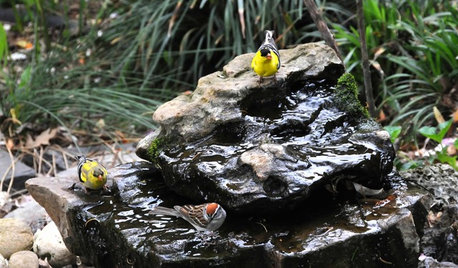Separating worms from vermicompost
zaleon
15 years ago
Related Stories

GARDENING GUIDESHouzz TV: Make a Worm Bin for Rich Soil and Happy Plants
A worm-powered compost bin that can fit under a sink turns food scraps into a powerful amendment for your garden. Here’s how to make one
Full Story
HEALTHY HOME6 Tips From a Nearly Zero-Waste Home
Lower your trash output and increase your quality of life with these ideas from a mom who did it to the max
Full Story
REMODELING GUIDES6 Must-Know Lessons From a Serial Renovator
Get your remodel right the first time, with this insight from an architect who's been there too many times to count
Full Story
MOST POPULARThanksgiving Tales: When the Turkey Tanks
Houzz readers prove adept at snatching victory from the jaws of entertaining defeat
Full Story
GARDENING GUIDESWhat Are Your Spring Gardening Plans?
Tearing out the lawn? Planting edibles? Starting from scratch? Tell us what you plan to change in your garden this year
Full Story
MOST POPULAREasy Green: 23 Ways to Reduce Waste at Home
Pick from this plethora of earth-friendly ideas to send less to the landfill and keep more money in your pocket
Full Story
OUTDOOR PROJECTSBring In the Birds With a Homemade Bubble Rock
An avian expert from Southern Indiana shows how to make a burbling fountain that migrating birds will love
Full Story
EDIBLE GARDENSSummer Crops: How to Grow Tomatoes
Plant tomato seedlings in spring for one of the best tastes of summer, fresh from your backyard
Full Story
HOUZZ TOURSHouzz Tour: For the Love of a Cat in Philadelphia
Pet-friendly features integrated into a mod, eclectic and colorful home mean everyone in the family is happy
Full Story
GARDENING GUIDESGet on a Composting Kick (Hello, Free Fertilizer!)
Quit shelling out for pricey substitutes that aren’t even as good. Here’s how to give your soil the best while lightening your trash load
Full StorySponsored
More Discussions






folly_grows
hamiltongardener
Related Professionals
Hershey Landscape Architects & Landscape Designers · Rancho Cordova Landscape Architects & Landscape Designers · Norwood Landscape Contractors · Surprise Landscape Contractors · Tempe Landscape Contractors · Canton Landscape Contractors · Cornelius Landscape Contractors · La Mirada Landscape Contractors · Mendota Heights Landscape Contractors · Norristown Landscape Contractors · Rochester Landscape Contractors · Avon Lake General Contractors · New Carrollton General Contractors · North Tustin General Contractors · Avocado Heights General Contractorsflowersnow
hamiltongardener
bencjedi
seamommy
Jasdip
takadi
flowersnow
susanfromhawaii
gringojay
wormnelly
cathd66
tclynx
kioni
ncdirtdigger
fosteem1
beebiz1960